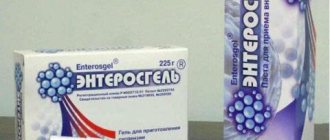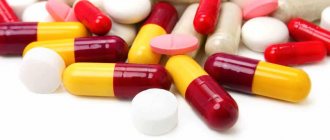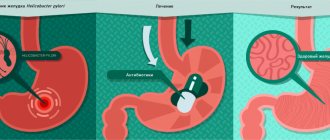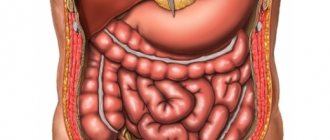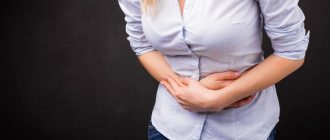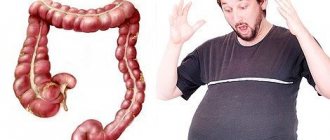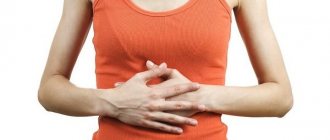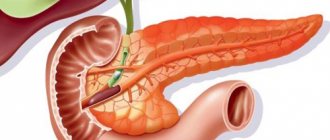Gastritis
Inflammation of the gastric mucosa. When the disease occurs, the inner wall of the organ is destroyed: it atrophies or erosions appear on it. Destruction of organ tissue leads to painful discomfort in the solar plexus.
Causes
One common cause is Helicobacter pylori. Inflammation caused by the penetration of bacteria is detected in most patients.
In addition to the infectious factor, gastritis can be triggered by:
- unhealthy diet (frequent dry snacks, abuse of spices);
- smoking;
- frequent drinking;
- taking certain medications (Aspirin, NSAIDs);
- reflux reflux (the contents of the duodenum enter the lower parts of the stomach through an incompletely closed sphincter);
- autoimmune processes;
- poisoning
More often, gastritis is provoked by the combined influence of several factors. A person eats poorly, smokes, and this creates favorable conditions for Helicobacter pylori to enter the body.
Symptoms
There are acute and chronic forms of the disease. The nature and intensity of pain depends on the form of the pathology.
Acute
More often the cause of the disease is poisoning with low-quality products, alkalis or acids. In this case, the patient appears:
- severe paroxysmal pain in the solar plexus;
- nausea and vomiting;
- flatulence;
- diarrhea.
The intensity of symptoms depends on the amount and irritating effect of the toxic substance.
Chronic
The pathological process is characterized by the appearance of aching or pressing pain in the solar plexus, which intensifies after eating. In addition to pain, people experience:
- heartburn;
- unpleasant belching;
- nausea (vomiting is rare);
- feeling of heaviness in the epigastric region;
- "grumbling" in the stomach;
- increased gas formation;
- bowel disorders (diarrhea will alternate with constipation;
- decreased appetite.
Due to the fact that the stomach begins to hurt after eating, a person tries to eat less to avoid discomfort. Those who have been suffering from chronic gastritis for a long time experience a decrease in body weight, lethargy and drowsiness, and deterioration in performance.
Treatment
Therapy depends on the form of the disease. For acute gastritis it is indicated:
- gastric lavage;
- cleansing enema;
- taking sorbents (Activated carbon);
- intravenous infusions to replenish fluid loss and reduce intoxication.
Drug treatment for acute and exacerbation of chronic gastritis is the same and depends on the cause of the disease.
Patients are prescribed:
- antibiotics (if the causative agent is Helicobacter);
- antacids (Maalox, Omez) for high acidity;
- digestive enzymes (if acid production is reduced);
- antispasmodics (Platifillin, Drotaverine);
- antiemetics (Metoclopramide).
In addition to taking medications, patients are advised to adhere to a gentle diet. It is forbidden to eat foods that irritate the gastric mucosa (spicy, smoked, spicy, etc.). The diet must be followed not only during an exacerbation, but also during remission.
Which doctor treats
If you suspect stomach pain, you should visit a gastroenterologist or therapist.
Pain as a symptom of another disease
Pain in the node area occurs not only due to injuries, but also becomes a symptom of serious diseases of human organs. The nature and location determines which organ in the body is affected.
Gastrointestinal tract
Such diseases more often than others cause anxiety and pain in the celiac plexus, because the human stomach is in close proximity to the celiac plexus.
Human gastrointestinal tract
- Gastritis is a pathology of the gastrointestinal tract. Inflammation of the mucous membrane of the fundus of the stomach causes acute pain a couple of minutes after eating. If the lower part of the stomach is bothered, discomfort may occur much later or on an empty stomach. Patients complain of aching pain in the stomach, heaviness in the abdomen and difficulty sleeping. Belching air and heartburn are bothersome. To cure gastritis, it is important to adhere to a strict diet. A gastroenterologist will prescribe fractional meals and medications.
- Stomach ulcer. The disease occurs as a consequence of incurable gastritis. It can be caused by poor diet and frequent stressful situations. People suffering from ulcers often complain of pain in the stomach, heaviness of the abdomen after eating, nausea, severe vomiting, and increased plaque on the tongue. A gastroenterologist treats stomach ulcers. If you do not start timely treatment, complications will arise and the need for surgical intervention.
- Tumor and cancer. Leading an unhealthy lifestyle, drinking alcohol, using drugs, and smoking in large doses causes serious harm to the human body. Ignoring doctors while suffering from gastritis or ulcers contributes to the development of tumors and cancer cells. At the initial stage, there may be no obvious manifestations, but gradually it manifests itself as increased body temperature, decreased appetite, constant vomiting, and weight loss. In the early stages of tumor development, surgery can help. Cancer diseases lead to the death of the patient.
Duodenum
- Duodenitis can develop even in childhood. In addition to pain in the area of accumulation of nerve endings, weakening of the body and previous nausea and vomiting are considered obvious symptoms. Sometimes the stomach may not hurt until you touch it. For duodenitis, fasting and bed rest are observed for the first days.
- When a tumor of the duodenum occurs, the pain in the celiac ganglion is not so severe; it is difficult to recognize the disease in the early stages.
duodenum
Pancreas
- Pancreatitis is accompanied by severe acute pain. Additional symptoms: fever, constant nausea and vomiting with large amounts of bile. Pancreatitis can be acute or chronic. The disease is characterized by the fact that the urge to vomit does not stop for a long time, and relief does not come. Treatment is carried out in a hospital.
- A pancreatic tumor is accompanied by similar symptoms as pancreatitis, possibly bloating and digestive disorders.
- Peptic ulcer disease in the pancreas is marked by sharp spasms in the area of the nerve ganglion. They occur more often at night on an empty stomach. Nausea and vomiting are also inherent in peptic ulcer disease.
Small intestine
There are dozens of diseases in the small intestine, the symptom of which is pain in the area of the nerve ganglion. It is not easy to identify them without the help of a specialist, even knowing additional symptoms.
- Intestinal infections are characterized by severe diarrhea with mucus, and the color of the stool changes to green or very pale. Vomiting and nausea are noted.
- Peritonitis can lead to the formation of neuralgia.
- Adhesions in the abdominal cavity and intestines are accompanied by similar ailments as neuralgia and neuritis.
- Helminthic infestations overwhelm the intestines, putting pressure on the organs, causing discomfort in the nerve cluster.
- Tumors of the stomach, intestines and other abdominal organs lead to varying degrees of pain in the solar plexus.
- An intestinal ulcer leads to disturbances in the digestive process and moderate ailments.
- Food poisoning, like an intestinal infection, is accompanied by similar symptoms.
If the sensation of pain is not in the center of the solar plexus, but higher or lower in the stomach:
- Pain under the solar plexus often worries women as a consequence of diseases of the genital organs.
- Ailment just above the celiac plexus often occurs due to heart problems. The pain is dull and aching and can pierce the heart.
- Ulcerative colitis is accompanied by similar symptoms as most diseases of the digestive system and gastrointestinal tract.
If a person has a stomach ache in the solar plexus area, one should not hesitate. This malaise is considered a symptom of many serious diseases. The cause of the illness does not always become clear immediately; you will need to undergo examination by specialists and take tests to determine the true cause of the illness. Any diagnosis must be accepted. Self-medication in this situation will not lead to good things.
Pathologies of the duodenum
Inflammation, erosion or atrophic processes in the duodenal mucosa negatively affect digestive function. The pain will be just below the stomach, on the right side of the solar plexus.
Causes
The development of diseases of the duodenum is provoked by:
- poor nutrition;
- smoking or alcohol abuse;
- indigestion in the stomach;
- helminthic infestations;
- metabolic disorders (gout, diabetes, diseases accompanied by the formation of stones);
- entry of an infectious pathogen.
Pathologies of the duodenum are rarely diagnosed as an independent disease. More often, atrophy or inflammation occurs as a complication of chronic gastritis.
Symptoms
It will hurt in different ways, depending on the cause and nature of the pathological process. Pain manifestations can be sharp, aching or dull. In addition to pain, a person experiences:
- nausea;
- urge to vomit;
- problems with stool;
- belching.
The source of pain is located slightly to the right of the midline between the navel and solar plexus.
Treatment
The selection of medications is carried out taking into account the provoking factor. Patients are prescribed:
- antibacterial therapy;
- analgesics and antispasmodics;
- agents that reduce gastric acidity;
- anthelmintic drugs (if the cause is parasites).
Surgical treatment is used if the pathological process is accompanied by the appearance of scars, hernias or tumors that prevent the advancement of the food bolus. Then the deformed area is excised, sometimes including part of the stomach.
Who to contact
Therapeutic tactics to eliminate signs of duodenal pathologies are selected by a gastroenterologist or surgeon.
Causes of pain syndrome
The main causes of pain in the solar plexus can be divided into 2 groups:
- Damage to the nerve fibers themselves due to injury, bacterial or viral inflammation.
- Reactive pain due to a disease of one of the abdominal organs, to which sensory fibers from the splanchnitic plexus approach.
In the first type of pathology, the functioning of one or several organs of the cavity may be disrupted; in the second case, pain in the plexus will be a consequence of organ pathology. Only specialists with medical education can determine what was primary and what developed as a result. Below we will look at the main symptoms in order to quickly determine which doctor you need to consult.
Peptic ulcer
The gradual destruction of the mucous membrane provokes the formation of ulcerations. Small injuries gradually grow and lead to deep damage to the walls of the organ. The ulcer can be localized in the stomach or duodenum.
Causes
The development of ulcers is provoked by non-compliance with diet and lack of treatment for the following pathologies:
- gastritis;
- duodenal diseases.
Where in the solar plexus it will hurt depends on the location of the ulcer. This may be the epigastric region or an area slightly lower with a slight shift to the right from the center line of the abdomen.
Symptoms
When the ulcer worsens, there is acute pain in the solar plexus. Patients describe the pain as “dagger-like” or burning. During remission the pain is moderate.
In addition to pain, the following symptoms occur:
- belching;
- heartburn;
- nausea;
- vomiting food, after which the patient feels relief;
- the appearance of cramps in the upper abdomen;
- problems with sleep (ulcer sufferers often have solar plexus pain at night);
- constant feeling of fatigue;
- atony;
- constipation (diarrhea occurs rarely).
Peptic ulcer disease is characterized by the appearance of hunger pains. This is because during prolonged fasting, digestive juices irritate the surface of the ulceration, causing painful discomfort.
Sharp pain in the solar plexus is caused by perforation of the ulcer when the contents of the organ enter the abdominal cavity.
Treatment
In case of exacerbation of a peptic ulcer, the patient is prescribed bed rest and a diet that prevents irritation of the digestive tract (mashed warm dishes without spices, with a small amount of salt).
Medicines prescribed:
- antibiotics (if there is a bacterial infection);
- acidity reducing agents;
- antispasmodics;
- medications to reduce secretory activity.
The goal of the therapy is to reduce irritation of the ulcerated area and ensure healing of the injury.
In case of perforation, surgical treatment is indicated. The affected area of the organ is excised along with the surrounding healthy tissue.
Which doctor should I contact?
If you feel acute pain in the solar plexus, and have a history of stomach or duodenal diseases, then first of all you need to visit a gastroenterologist.
Excessive exercise
Physical education and sports have health benefits. But if you exercise too hard during weightlifting, pain may develop. Powerlifting and working with serious weights is a rather traumatic activity. Beginners often perform barbell exercises without proper technique and without the supervision of an experienced trainer, which leads to many health problems.
Pain in the solar plexus after physical activity is also not uncommon. For example, if you carry heavy building materials from place to place for several hours or unload large goods, you should not be surprised at the appearance of pain in the solar plexus. What is it and how to deal with it in this case?
The first rule for treating pain in the epigastric region after physical work and heavy lifting is complete rest. Bed rest for two to three days is necessary for the body to recover from overwork. If you do not follow this rule and continue to overwork, complications are possible (the development of a hernia, in women - prolapse of the uterus, inflammation of the solar plexus nerves).
Pancreatitis
Inflammation of pancreatic tissue is considered a dangerous disease. When it occurs, the ducts that ensure the flow of organ secretions into the small intestine are blocked and, under the influence of digestive enzymes, pathological “self-digestion” occurs.
Causes
Pancreatitis occurs due to the influence of the following factors:
- alcohol abuse;
- long-term use of antibiotics;
- chronic intoxication (in those working with industrial poisons);
- poor nutrition;
- unfavorable environmental situation.
The disease can develop slowly with a gradual increase in pain in the epigastric region or acutely, when it immediately begins to hurt severely in the solar plexus.
Symptoms
The acute form or exacerbation of a chronic process is characterized by pain surrounding the solar plexus and costal arches. In addition to pain, the patient experiences:
- nausea and vomiting;
- diarrhea;
- bloating;
- bluish skin in the umbilical area;
- decrease in blood pressure;
- cardiopalmus;
- confusion.
It hurts so much that the person rushes around trying to find a comfortable position and complains that it is hard to breathe.
In the chronic form, the symptoms are mild, pain and indigestion are relieved by taking medications, but parts of the organ slowly die off.
Treatment
Therapy depends on the severity of the inflammatory process.
Spicy
If the solar plexus and under the ribs hurt, and the symptoms of pancreatitis are severe, then hospitalization in a surgical or gastroenterology department is indicated. In stationary conditions the following is carried out:
- intravenous infusions (Reopoliglyukin, Reosorbilact);
- elimination of pain and spasm (Platifillin, Ketorolac, and in case of a severe pain attack, the administration of narcotic analgesics is possible);
- stopping vomiting (Cerucal);
- preventing organ swelling (Cerucal is used);
- replenishment of enzymatic deficiency (Contriven, Trasylol);
- decreased gastric secretion (Omez);
- increasing immune strength (vitamin therapy).
In the first days after an attack, patients are shown a starvation diet, and then gentle nutrition to reduce the load on the organ.
Chronic
If the disease is accompanied by moderate symptoms, then outpatient treatment is allowed. A gentle diet low in carbohydrates and fats is prescribed. To prevent pancreatic necrosis, patients are prescribed:
- enzymes (Pancreatin, Festal);
- proton pump inhibitors to reduce acidity (Omeprazole);
- antacids.
To relieve pain, it is recommended to use Drotaverine or Platiphylline.
The diet must be followed for life. Eating tasty prohibited foods provokes an exacerbation of pancreatitis.
Which doctor treats
Diseases of the pancreas are dealt with by gastroenterologists, surgeons and therapists.
Diagnostics
It is impossible to determine on your own why the solar plexus hurts, so it is important to consult a doctor in a timely manner. The symptom appears for various reasons. Some do not pose a threat to health, others, on the contrary, are life-threatening. Therefore, it is important to conduct a diagnosis, which may include the following methods:
- General clinical tests.
- Ultrasonography.
- CT scan.
- X-ray method using contrast.
- Laparoscopy.
- Fibrogastroduodenoscopy.
Interesting! How to use Enterosgel - contraindications and side effects
Liver and gallbladder
If a person has pain on the right, the cause may be liver disease, cholelithiasis or cholecystitis.
Causes
Provokes the development of pathologies:
- bile stagnation;
- bacteria and viruses;
- helminthic infestations;
- diabetes;
- violation of metabolic processes;
- hormonal imbalances;
- overweight.
Often, diseases of the gallbladder or liver appear as a complication of diseases of the stomach or intestines.
Symptoms
Pathologies are always accompanied by pain to the right of the solar plexus. Other symptoms depend on the nature of the disease. It could be:
- bitter belching;
- vomiting of bile that does not bring relief;
- tachycardia;
- yellowing of the sclera and skin;
- fever.
During an acute pain attack, not only the solar plexus and ribs on the right hurt, the pain radiates to the right arm, shoulder and neck.
Treatment
Depending on the nature of the pathological process, the following is prescribed:
- antibiotics;
- antiviral agents;
- anthelminthic drugs;
- medications to relieve spasm and pain;
- drugs that reduce gastric secretory function.
Diet plays an important role in the healing process. Patients with cholecystitis, gallstones or liver inflammation should forget about alcohol, spices, and fatty foods.
Who to contact
If pain in the right side and solar plexus is accompanied by indigestion and/or yellowing of the skin, then you need to visit a gastroenterologist or surgeon.
Causes of pain in the solar plexus
The main causes of pain in the solar plexus area can be classified into the following types:
- Pathology of nerve fibers caused by traumatic injury, inflammation (bacterial, viral). In this case, the pathology can lead to disruption of the functioning of the abdominal organs.
- Reactive pain caused by damage or dysfunction of one of the abdominal organs to which sensory nerve fibers are connected. In this situation, pain in the diaphragm is the result of organ pathology. Only highly qualified doctors can make an accurate diagnosis: what was the cause and what was the consequence.
- Neuritis is part of the group of inflammatory diseases. The cause may be prolonged neuralgia, physical passivity, as well as excessive physical exertion, infectious bowel diseases, etc. This type of illness is characterized by the following symptoms: attacks of acute pain in the diaphragm, most often spreading further to the solar plexus, however, can cover the entire abdominal cavity and part of the back. Painful attacks are accompanied by heat in the abdomen, and you can also observe an increase in the intensity of pain after suffering stress or heavy physical labor. Only a doctor can diagnose and prescribe treatment for a patient suffering from neuritis.
- Neuralgia is quite difficult to distinguish by pain and without a doctor’s diagnosis this is impossible. It can be caused by intestinal infections, injuries, parasitic infections (worms). Most often, the pain is felt in other organs: the stomach, intestines, heart.
- Solaritis is one of the most complex and dangerous diseases of the solar plexus; it can occur in acute or chronic form (prolonged and periodic occurrence and course of attacks). It is an inflammation of the nerve fibers and endings that make up the solar node - the center of all the nerve branches of the organ. The disease can be caused by prolonged neuralgia or neuritis, which have not been subjected to any special treatment. Exacerbation of chronic solarium can be caused by heavy physical exertion, a person’s stressful state, diseases of the gastrointestinal tract, and hypothermia. Pain with solarium occurs as follows: a pressing feeling of heaviness in the chest, heaviness in the stomach, increased temperature in the abdominal cavity, constipation, poor appetite, heartburn. Ignoring the symptoms will lead to serious disorders of the nervous system .
- Intense physical activity . Usually, acute stabbing pain only indicates a large amount of physical activity, and a little rest, balanced training, and competent loads will help you get rid of the unpleasant sensations. Otherwise, constant heavy overload can lead to neuritis.
- Force impact - i.e. injuries can be of 3 types: 1. a strong, targeted blow to the stomach, to the solar plexus; 2. hitting the ball while playing sports;3. too tight things, belts; As a rule, the pain from a blow is several times stronger than that caused by physical exertion and is characterized by an acute burning sensation, which may be accompanied by a feeling of increased temperature in the abdominal cavity, nausea, shortness of breath (most often, there are difficulties so that the victim of the blow is able to breathe air freely) , unpleasant sensations can also cover the chest. It is quite easy to put the victim in order: just help him take a horizontal position and massage the diaphragm.
Osteochondrosis or hernia of the thoracic spine
Another reason why the solar plexus hurts is spinal pathology. When the nerve processes are pinched, innervation is disrupted, and the pain can radiate to the epigastric region.
Causes
Spinal diseases are caused by:
- physical inactivity;
- great physical activity;
- lack of nutrients;
- back injuries;
- degenerative processes in intervertebral discs;
- circulatory disorders in the thoracic region.
Osteochondrosis and intervertebral hernias develop slowly.
Symptoms
In diseases of the spine, pain in the celiac plexus is rarely acute. The pain is usually mild or moderate.
It can be assumed that the pain syndrome is associated with back diseases based on the following signs:
- Connection with movement. The pain intensifies with certain movements (raising the arm, turning the body) and subsides or completely disappears at rest.
- Lack of connection with food intake. It will hurt the same before and after eating.
- Spilled character. The pain is localized not only in the solar plexus; the back and ribs also hurt.
Such patients have a history of osteochondrosis or previous spinal injuries.
Treatment
During the examination, the doctor finds out the causes and prescribes treatment taking into account the pathology of the spine. Patients may be prescribed:
- non-steroidal anti-inflammatory drugs;
- chondroprotectors for the restoration of cartilage tissue;
- analgesics;
- ointments with a warming and anti-inflammatory effect.
In addition to drug treatment, physiotherapy is prescribed to speed up recovery:
- magnet;
- laser;
- electrophoresis;
- acupuncture.
Osteochondrosis is an incurable disease with frequent exacerbations and patients should know what to do with such pain.
Which doctor treats
If you have diseases of the spine, you should consult a neurologist or orthopedist.
Traditional methods of dealing with pain in the epigastric region
Some patients avoid visiting a doctor due to mistrust or lack of time. You can try to relieve pain in the solar plexus using the following simple traditional medicine tips:
- yarrow infusion (a teaspoon of crushed dry herb per glass of boiling water) effectively relieves inflammatory processes in the body and has a mild analgesic effect;
- a hot bath for ten to twenty minutes has a muscle relaxant and sedative effect, this will help relieve pain in the epigastric region;
- You should avoid eating fatty, high-calorie foods and give preference to vegetables, fruits, rice and buckwheat dishes, and vegetable broths.
- honey and bee products - a teaspoon on an empty stomach daily (honey is famous for its anti-inflammatory and mild anesthetic properties).
Angina and heart attack
It is commonly believed that heart pain affects the left chest, but this is not always the case. Irradiation to the epigastric region is possible.
Causes
Violation of coronary blood flow causes oxygen starvation of the myocardium. Provoke the disease:
- vasospasm (angina attack);
- blockage of an artery by a blood clot or atherosclerotic plaque (heart attack).
The difference between angina pectoris and a heart attack is that vascular spasm is eliminated by taking drugs with nitroglycerin (Nitrosprey, Isoket).
Symptoms
The main symptom is sharp pain, which decreases slightly at rest. Only the solar plexus may hurt, or pain will also be felt in the chest on the left.
A distinctive feature of heart diseases is that the pain syndrome does not disappear after taking analgesics or antispasmodics.
Treatment
The choice of drugs depends on the characteristics of the coronary blood flow disorder.
Short-term spasms
For angina pectoris that occurs after physical activity or emotional stress, to improve the patient’s condition, the following is prescribed:
- Antihypertensive drugs. An increase in blood pressure provokes vascular spasm.
- Cholesterol lowering drugs. Plaques formed during atherosclerosis obstruct blood flow.
- Blood thinners. Reduce the risk of intravascular thrombus formation.
To stop an attack, short-acting nitrates are used.
Vessel blockage
If there is a cessation of blood flow due to the closure of the vascular lumen, then nitroglycerin will bring minor relief. Heart attacks are treated in a hospital, where to alleviate the patient’s condition and reduce the focus of necrosis, the following is used:
- thrombolysis;
- narcotic analgesics.
Further therapy is aimed at maintaining heart function.
According to indications, surgical treatment can be performed when a blockage is found and removed surgically, or a stent is applied to allow blood access to bypass the closed section of the vessel.
Which doctor treats
If you have a heart attack or angina, you should contact a cardiologist.
Treatment
Pain in the solar plexus area can occur in adults and children; the pathology requires immediate medical attention. The first step is a detailed diagnosis followed by the prescription of an adequate treatment regimen. If the cause of the pain is a blow to the solar plexus, drug therapy is not required, but taking a horizontal position will not hurt. When other pathogenic factors occur, the doctor prescribes treatment strictly according to indications.
Solarita
With this disease, you need to contact a neurologist who will offer an integrated approach for a speedy recovery. The first step is to determine the root cause, especially if it is a toxic or infectious form. Doctors eliminate the primary diagnosis using medication, and to suppress progressive solaritis, therapeutic measures include:
- massage course;
- therapeutic exercises;
- physiotherapy;
- breathing exercises;
- taking non-steroidal anti-inflammatory drugs.
Neuritis
This diagnosis requires a competent determination of the root cause and its subsequent elimination. If this is bacterial neuritis, you cannot do without additional antibiotics, otherwise attacks of pain will remind you more and more often. When the main cause of pain is extensive myocardial pathology, doctors additionally recommend vasoconstrictor drugs. After eliminating the main diagnosis, treatment is symptomatic and includes the following measures:
- physiotherapeutic procedures;
- massage course;
- breathing exercises.
If the underlying disease is finally eliminated, attacks of pain on the right or left side of the solar plexus will no longer disturb the patient.
What is the solar plexus? This is the area that is located between the chest and intestines - that is, the midline of the abdominal cavity. It’s also no secret that the solar plexus is the area of the largest concentration of nerve endings .
Pain in the solar plexus area can be an indicator of diseases of a different spectrum:
- About diseases of the abdominal organs;
- About the inflammatory process of nerve endings, which is extremely dangerous, because the plexus controls a person’s breathing and can stop it altogether;
The abdominal cavity and chest are separated by only one muscle - the diaphragm, the main function of which is breathing. The aorta is the largest artery in the human body and moves through an opening in the diaphragm from the chest. At the back, in the lumbar region, there is a huge accumulation of nerve endings that form several nodes.
Other causes of pain in the celiac region
Let's look at why the epigastric region may still hurt:
- Neuritis and neuralgia. Inflammation or irritation of the nerve processes causes paroxysmal pain in the plexus area.
- Irritation of nerve nodes. The epigastric region contains a powerful nerve plexus, and short-term irritation of the nerves can occur with excessive physical exertion.
- Wearing tight clothing. In women, acute pain in the solar plexus area often appears when ladies, wanting to become slimmer, tighten corsets tightly or purchase very tight underwear.
- Injuries. This nuisance awaits fans of ball games or people who are fond of contact sports. When practicing martial arts or boxing, men's solar plexus hurts due to frequent blows to this area.
- Intestinal diseases. Enteritis and other inflammatory processes of the intestinal mucosa provoke pain. Pain localized below the solar plexus is accompanied by stool disorder (usually diarrhea).
Pain in the solar plexus may be due to irritation of the nerve nodes, or pain will appear due to pathologies of organs located nearby.
External injuries and various lesions
The causes of such ailments are physical activity, trauma to the nerve ganglion area and neuralgia.
Excessive physical labor
In this case, the nature of the pain takes on a sharp and stabbing form. Painful sensations appear suddenly and suddenly disappear after rest. They occur during sports or due to heavy physical work. Special treatment in this situation is not required; reducing the load, more rest or changing jobs will help.
Solar plexus injuries
A strong blow to this area can lead to rupture of the diaphragmatic muscle. A hernia occurs, which only a surgeon can remove. At best, the blow will simply disrupt breathing and lead to loss of consciousness. The resulting injury leads to immediate and sharp pain in the abdomen and difficulty breathing. The person even feels nauseous at first.
The victim must be laid on a flat surface, everything possible must be done to restore normal breathing, and a light massage of the affected area must be done. If a person cannot speak and is unconscious, ammonia will help bring him to his senses. In case of vomiting and convulsions, urgently call an ambulance. If severe abdominal pain continues to bother you even after days, this means the development of an inflammatory process.
Neuritis and neuralgia
The cause of neuritis is viral or bacterial infections, intoxication of the body, compression of the nerves or hypothermia. In this case, the nerve endings become inflamed, creating unpleasant painful sensations in the stomach area. Stress and heavy physical activity will only intensify pain attacks. Neuritis is characterized by: a sharp attack of acute pain, often radiating to the back, bursting sensations in the abdominal area.
Neuralgia can be caused by an infectious intestinal disease, worms and previous injuries. The symptoms of the two diseases are very similar; only an experienced neurologist will be able to determine the cause of the ailment and make a diagnosis.
The treatment of neuralgia will be taking medications that help increase the conductivity of nerve fibers, stimulants of biological origin and B vitamins.
Solarite
The most severe damage to the celiac node, which is accompanied by the occurrence of additional inflammatory processes. Solaritis is recognized as a consequence of prolonged neuritis or neuralgia, which was not treated in time. It occurs in an acute form with a considerable number of symptoms: pressing pain in the chest and heart, a feeling of heat from the inside without an increase in body temperature, disruption of the intestines, stomach tone, bloating in the abdomen.
Healing massages, special gymnastics and physiotherapy are what doctors usually prescribe when solaritis is diagnosed.
Short summary
If your solar plexus hurts, then a visit to the doctor is necessary. Let's consider when emergency medical care is needed, and when a planned visit to the clinic is possible:
- Nature of pain. If the pain is acute, then you need to call an ambulance, and if there is a nagging pain in the solar plexus and the cause is known (diet violation, exacerbation of osteochondrosis), then a scheduled visit to the clinic is indicated.
- Intensity. If the pain is severe, then immediate help is needed.
- Action of analgesics. If taking antispasmodics or painkillers is ineffective and pain in the solar plexus persists, then emergency hospitalization is required. The cause may be acute pancreatic necrosis or heart attack.
The causes of pain in the solar plexus can be relatively harmless (exacerbation of chronic gastritis or irritation of the nerve node during physical activity), or they can indicate a serious pathology (acute pancreatitis, heart attack). Do not ignore the pain that has arisen. Timely seeking medical help will help avoid serious complications.
Found a mistake? Select it and press Ctrl + Enter
Why else can the solar plexus hurt?
Let's look at less common causes of pain under the solar plexus:
- Intestines. When the duodenum or small intestine is inflamed, pain appears just below the solar plexus. If the pain is low, then perhaps the pathological process affects part of the large intestine.
- Wearing tight things. More often than not, women suffer from this when they choose narrow clothes. In this case, pain below the solar plexus will be associated with wearing certain clothes.
- Irritation of the nerve plexuses. Nerve plexuses are localized in the celiac region, irritation of which can be accompanied by pain. The provoking factor will be hard work or injury.
© shutterstock
Pain in the solar plexus can occur for various reasons. But if pain occurs frequently or painful discomfort does not go away for a long time, you should visit a doctor.
